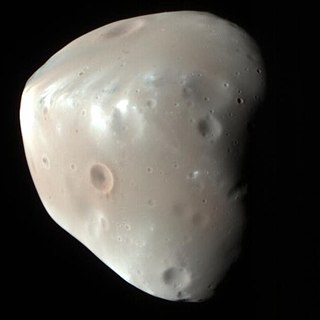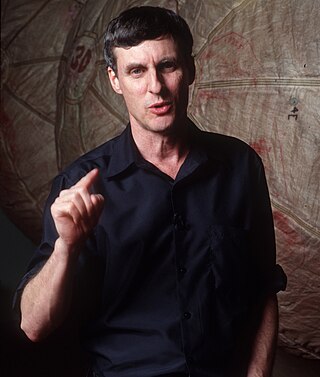
Jet Propulsion Laboratory (JPL) is a federally funded research and development center in Pasadena, California, United States. Founded in 1936 by Caltech researchers, the laboratory is now owned and sponsored by the National Aeronautics and Space Administration (NASA) and administered and managed by the California Institute of Technology.

Phobos is the innermost and larger of the two natural satellites of Mars, the other being Deimos. The two moons were discovered in 1877 by American astronomer Asaph Hall. It is named after Phobos, the Greek god of fear and panic, who is the son of Ares (Mars) and twin brother of Deimos.

Deimos is the smaller and outer of the two natural satellites of Mars, the other being Phobos. Deimos has a mean radius of 6.2 km (3.9 mi) and takes 30.3 hours to orbit Mars. Deimos is 23,460 km (14,580 mi) from Mars, much farther than Mars's other moon, Phobos. It is named after Deimos, the Ancient Greek god and personification of dread and terror.

The Discovery Program is a series of Solar System exploration missions funded by the U.S. National Aeronautics and Space Administration (NASA) through its Planetary Missions Program Office. The cost of each mission is capped at a lower level than missions from NASA's New Frontiers or Flagship Programs. As a result, Discovery missions tend to be more focused on a specific scientific goal rather than serving a general purpose.

Steven Weldon Squyres is an American geologist and planetary scientist. He was the James A. Weeks Professor of Physical Sciences at Cornell University in Ithaca, New York. His research area is in planetary sciences, with a focus on large solid bodies in the Solar System such as the terrestrial planets and the moons of the Jovian planets. Squyres was the principal investigator of the Mars Exploration Rover Mission (MER).

Planetary geology, alternatively known as astrogeology or exogeology, is a planetary science discipline concerned with the geology of celestial bodies such as planets and their moons, asteroids, comets, and meteorites. Although the geo- prefix typically indicates topics of or relating to Earth, planetary geology is named as such for historical and convenience reasons; due to the types of investigations involved, it is closely linked with Earth-based geology. These investigations are centered around the composition, structure, processes, and history of a celestial body.

The two moons of Mars are Phobos and Deimos. They are irregular in shape. Both were discovered by American astronomer Asaph Hall in August 1877 and are named after the Greek mythological twin characters Phobos and Deimos who accompanied their father Ares into battle. Ares, the god of war, was known to the Romans as Mars.

Pascal Lee is co-founder and chairman of the Mars Institute, a planetary scientist at the SETI Institute, and the Principal Investigator of the Haughton-Mars Project (HMP) at NASA Ames Research Center in Mountain View, California. He holds an ME in geology and geophysics from the University of Paris, and a PhD in astronomy and space sciences from Cornell University.

65803 Didymos is a sub-kilometer asteroid and binary system that is classified as a potentially hazardous asteroid and near-Earth object of the Apollo group. The asteroid was discovered in 1996 by the Spacewatch survey at Kitt Peak, and its small 160-meter minor-planet moon, named Dimorphos, was discovered in 2003. Due to its binary nature, the asteroid was then named Didymos, the Greek word for 'twin'.

Discovery and exploration of the Solar System is observation, visitation, and increase in knowledge and understanding of Earth's "cosmic neighborhood". This includes the Sun, Earth and the Moon, the major planets Mercury, Venus, Mars, Jupiter, Saturn, Uranus, and Neptune, their satellites, as well as smaller bodies including comets, asteroids, and dust.
Philip D. Nicholson is an Australian-born professor of astronomy at Cornell University in the Astronomy department specialising in Planetary Sciences. He was editor-in-chief of the journal Icarus between 1998 and 2018.

The Planetary Science Decadal Survey is a serial publication of the United States National Research Council produced for NASA and other United States Government Agencies such as the National Science Foundation. The documents identify key questions facing planetary science and outlines recommendations for space and ground-based exploration ten years into the future. Missions to gather data to answer these big questions are described and prioritized, where appropriate. Similar decadal surveys cover astronomy and astrophysics, earth science, and heliophysics.

Ronald Greeley was a Regents’ Professor in the School of Earth and Space Exploration (SESE) at Arizona State University (ASU), the Director of the NASA-ASU Regional Planetary Image Facility (RPIF), and Principal Investigator of the Planetary Aeolian Laboratory at NASA-Ames Research Center. He was involved with lunar and planetary studies since 1967 and most recently focused his research on understanding planetary surface processes and geologic histories.

A planetary surface is where the solid or liquid material of certain types of astronomical objects contacts the atmosphere or outer space. Planetary surfaces are found on solid objects of planetary mass, including terrestrial planets, dwarf planets, natural satellites, planetesimals and many other small Solar System bodies (SSSBs). The study of planetary surfaces is a field of planetary geology known as surface geology, but also a focus on a number of fields including planetary cartography, topography, geomorphology, atmospheric sciences, and astronomy. Land is the term given to non-liquid planetary surfaces. The term landing is used to describe the collision of an object with a planetary surface and is usually at a velocity in which the object can remain intact and remain attached.

Meenakshi Wadhwa is a planetary scientist and educator who studies the formation and evolution of the Solar System through the analysis of planetary materials including meteorites, Moon rocks and other extraterrestrial samples returned by spacecraft missions. She is director of the School of Earth and Space Exploration at Arizona State University.

Mastcam-Z is a multispectral, stereoscopic imaging instrument. It serves as the primary science camera on NASA's Perseverance rover. The Principal Investigator is Jim Bell of Arizona State University. The instrument was designed and built by Malin Space Science Systems in San Diego, California.














